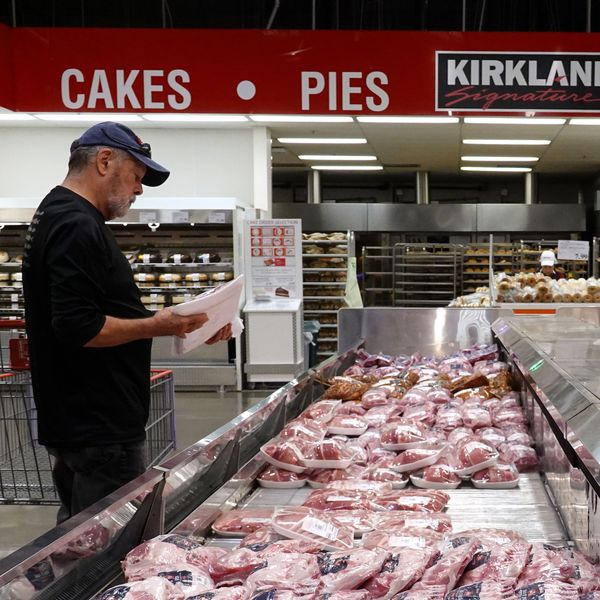Food Shouldn't be a Poker Chip
Commodities markets are dominated by speculators who have never gotten their hands dirty in a corn field.
This Thanksgiving, most farmers around my hometown in central
Minnesota are celebrating a good harvest. Rain--for once--fell at the
right time in the right amounts, and prices for many crops grown in
Litchfield are high.
After yo-yoing up and down for the past several years, corn prices
are particularly high. In mid-October, the national average was $4.78
per bushel, up $1.17 from the year before. Corn-Belt families still have
to cover the costs of expensive fertilizer and other inputs, but many
will be able to enjoy a more bountiful holiday this year.
In the long term, however, such drastic price swings are as bad for
farmers as they are for consumers. How do you plan for the future? If
farmers make plans now to plant more corn next year, the price bubble
may pop before they can sell their crops.
One
reason agricultural commodity prices have been so volatile is the
rampant gambling in the futures markets. These markets were originally
created to help ensure more stable prices for the actual producers of
corn, wheat, milk, and other commodities, as well as food manufacturers,
like flour mills and cereal makers.
A farmer-owned grain elevator, for example, can use a futures
contract like insurance to fix a price for a future sale. This allows
them to plan ahead without having to worry about wild price swings.
Today, however, the commodities markets are dominated by speculators
who have never gotten their hands dirty in a corn field, or come
anywhere near a food processing plant. They're simply big-time gamblers,
hoping to profit from changes in futures prices.
It's now widely recognized that excessive speculation played a
significant role in the 2008 food crisis, when soaring prices pushed 130
million people into hunger in the world's poorest countries. Here in
the United States, consumers also faced the sharpest increases in
grocery prices since 1980. These problems were exacerbated by the
dismantling, over the past couple of decades, of programs designed to
protect farmers and consumers, such as food reserves, price supports,
and import controls.
The financial reform bill that became U.S. law in July made some
progress in cracking down on speculation. It limits how much a trader
can hold in a certain commodity and increases market transparency.
However, the new law doesn't address problems with commodity index
funds and exchange-traded funds. Institutional investors like pension
funds and university endowments have been plowing money into such funds,
driving prices artificially high. Then, as we saw with the 2008 crash,
speculators can exit in a stampede, causing prices to plummet.
A coalition of family farm, faith-based and anti-hunger groups, along
with business associations have initiated a campaign to persuade
investors to pull out of commodity index funds. Their first target:
CALSTRS, the California teachers' retirement system, which had been
considering shifting $2.5 billion of their portfolio into commodities.
In response to the divestment campaign, the CALSTRS board decided on
November 4 to adopt a different strategy. Instead of $2.5 billion, they
will invest no more than $150 million in commodities for 18 months,
while further studying the potential problems.
This is an important step towards shutting down the global financial
casino where food is traded like a poker chip. The big-time gamblers
should stick to the Las Vegas casinos. Let's keep food where it should
be--on our tables.
An Urgent Message From Our Co-Founder
Dear Common Dreams reader, The U.S. is on a fast track to authoritarianism like nothing I've ever seen. Meanwhile, corporate news outlets are utterly capitulating to Trump, twisting their coverage to avoid drawing his ire while lining up to stuff cash in his pockets. That's why I believe that Common Dreams is doing the best and most consequential reporting that we've ever done. Our small but mighty team is a progressive reporting powerhouse, covering the news every day that the corporate media never will. Our mission has always been simple: To inform. To inspire. And to ignite change for the common good. Now here's the key piece that I want all our readers to understand: None of this would be possible without your financial support. That's not just some fundraising cliche. It's the absolute and literal truth. We don't accept corporate advertising and never will. We don't have a paywall because we don't think people should be blocked from critical news based on their ability to pay. Everything we do is funded by the donations of readers like you. Will you donate now to help power the nonprofit, independent reporting of Common Dreams? Thank you for being a vital member of our community. Together, we can keep independent journalism alive when it’s needed most. - Craig Brown, Co-founder |
This Thanksgiving, most farmers around my hometown in central
Minnesota are celebrating a good harvest. Rain--for once--fell at the
right time in the right amounts, and prices for many crops grown in
Litchfield are high.
After yo-yoing up and down for the past several years, corn prices
are particularly high. In mid-October, the national average was $4.78
per bushel, up $1.17 from the year before. Corn-Belt families still have
to cover the costs of expensive fertilizer and other inputs, but many
will be able to enjoy a more bountiful holiday this year.
In the long term, however, such drastic price swings are as bad for
farmers as they are for consumers. How do you plan for the future? If
farmers make plans now to plant more corn next year, the price bubble
may pop before they can sell their crops.
One
reason agricultural commodity prices have been so volatile is the
rampant gambling in the futures markets. These markets were originally
created to help ensure more stable prices for the actual producers of
corn, wheat, milk, and other commodities, as well as food manufacturers,
like flour mills and cereal makers.
A farmer-owned grain elevator, for example, can use a futures
contract like insurance to fix a price for a future sale. This allows
them to plan ahead without having to worry about wild price swings.
Today, however, the commodities markets are dominated by speculators
who have never gotten their hands dirty in a corn field, or come
anywhere near a food processing plant. They're simply big-time gamblers,
hoping to profit from changes in futures prices.
It's now widely recognized that excessive speculation played a
significant role in the 2008 food crisis, when soaring prices pushed 130
million people into hunger in the world's poorest countries. Here in
the United States, consumers also faced the sharpest increases in
grocery prices since 1980. These problems were exacerbated by the
dismantling, over the past couple of decades, of programs designed to
protect farmers and consumers, such as food reserves, price supports,
and import controls.
The financial reform bill that became U.S. law in July made some
progress in cracking down on speculation. It limits how much a trader
can hold in a certain commodity and increases market transparency.
However, the new law doesn't address problems with commodity index
funds and exchange-traded funds. Institutional investors like pension
funds and university endowments have been plowing money into such funds,
driving prices artificially high. Then, as we saw with the 2008 crash,
speculators can exit in a stampede, causing prices to plummet.
A coalition of family farm, faith-based and anti-hunger groups, along
with business associations have initiated a campaign to persuade
investors to pull out of commodity index funds. Their first target:
CALSTRS, the California teachers' retirement system, which had been
considering shifting $2.5 billion of their portfolio into commodities.
In response to the divestment campaign, the CALSTRS board decided on
November 4 to adopt a different strategy. Instead of $2.5 billion, they
will invest no more than $150 million in commodities for 18 months,
while further studying the potential problems.
This is an important step towards shutting down the global financial
casino where food is traded like a poker chip. The big-time gamblers
should stick to the Las Vegas casinos. Let's keep food where it should
be--on our tables.
This Thanksgiving, most farmers around my hometown in central
Minnesota are celebrating a good harvest. Rain--for once--fell at the
right time in the right amounts, and prices for many crops grown in
Litchfield are high.
After yo-yoing up and down for the past several years, corn prices
are particularly high. In mid-October, the national average was $4.78
per bushel, up $1.17 from the year before. Corn-Belt families still have
to cover the costs of expensive fertilizer and other inputs, but many
will be able to enjoy a more bountiful holiday this year.
In the long term, however, such drastic price swings are as bad for
farmers as they are for consumers. How do you plan for the future? If
farmers make plans now to plant more corn next year, the price bubble
may pop before they can sell their crops.
One
reason agricultural commodity prices have been so volatile is the
rampant gambling in the futures markets. These markets were originally
created to help ensure more stable prices for the actual producers of
corn, wheat, milk, and other commodities, as well as food manufacturers,
like flour mills and cereal makers.
A farmer-owned grain elevator, for example, can use a futures
contract like insurance to fix a price for a future sale. This allows
them to plan ahead without having to worry about wild price swings.
Today, however, the commodities markets are dominated by speculators
who have never gotten their hands dirty in a corn field, or come
anywhere near a food processing plant. They're simply big-time gamblers,
hoping to profit from changes in futures prices.
It's now widely recognized that excessive speculation played a
significant role in the 2008 food crisis, when soaring prices pushed 130
million people into hunger in the world's poorest countries. Here in
the United States, consumers also faced the sharpest increases in
grocery prices since 1980. These problems were exacerbated by the
dismantling, over the past couple of decades, of programs designed to
protect farmers and consumers, such as food reserves, price supports,
and import controls.
The financial reform bill that became U.S. law in July made some
progress in cracking down on speculation. It limits how much a trader
can hold in a certain commodity and increases market transparency.
However, the new law doesn't address problems with commodity index
funds and exchange-traded funds. Institutional investors like pension
funds and university endowments have been plowing money into such funds,
driving prices artificially high. Then, as we saw with the 2008 crash,
speculators can exit in a stampede, causing prices to plummet.
A coalition of family farm, faith-based and anti-hunger groups, along
with business associations have initiated a campaign to persuade
investors to pull out of commodity index funds. Their first target:
CALSTRS, the California teachers' retirement system, which had been
considering shifting $2.5 billion of their portfolio into commodities.
In response to the divestment campaign, the CALSTRS board decided on
November 4 to adopt a different strategy. Instead of $2.5 billion, they
will invest no more than $150 million in commodities for 18 months,
while further studying the potential problems.
This is an important step towards shutting down the global financial
casino where food is traded like a poker chip. The big-time gamblers
should stick to the Las Vegas casinos. Let's keep food where it should
be--on our tables.

